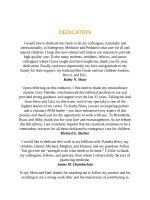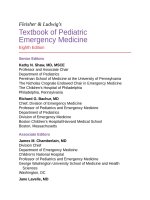Pediatric emergency medicine trisk 0326 0326
Bạn đang xem bản rút gọn của tài liệu. Xem và tải ngay bản đầy đủ của tài liệu tại đây (46.07 KB, 1 trang )
After the transport team has arrived at the referring facility, received a medical
handoff, and performed a preliminary evaluation of the patient, they often need to
communicate with one or more people at the receiving hospital. These calls
involve clinical review, patient disposition, scheduling of studies, need for
consultants, and other logistical issues. The ability to conference in various
participants, such as specialty physicians, charge nurses, and bedside nurses, can
greatly enhance the information flow, logistics, and care coordination of the
patient. Such calls are often best facilitated through a communication center. Use
of telemedicine technologies (photos, videos, etc.), in a Health Insurance
Portability and Accountability Act (HIPAA) compliant fashion, may be quite
helpful for the providers to ensure appropriate management.
En route to the receiving hospital, it may be necessary for the transport team to
contact the medical control physician either for advice or because the patient’s
medical condition has changed. Reliable communications are especially
important at this point in the transport. The team should be equipped with
redundant communication systems to ensure that a reliable means of
communication is always available. These could include cellular technology,
radio communication systems, and satellite phones where necessary. Additional
technologies, including web-based communications and global positioning
systems, may improve communication and logistics capabilities. Of course, the
transport control physician should always be immediately accessible to the
transport team.
After arrival at the receiving hospital, the transport team is responsible for
ensuring an efficient, informative, and seamless transition of care to the accepting
provider team. Adequate communication and information flow must take place to
fully inform the inpatient team of the patient’s disease process and care to date.
Complete documentation, written in a clear, concise fashion, is mandatory. A
formal “time out” for a handoff is a technique that programs have found to be
understood by providers, and useful in standardizing and focusing the transition
of care. Anything less than a complete medical transfer of information and a
seamless transition from referral physician, to the transport team, to the receiving
clinicians, is a disservice to the patient and a source of potential liability.
It is important to remember that transport communications may have medical–
legal ramifications. The most important of these involves the giving of medical
advice and the assumption of legal responsibility for patient management. When
giving or receiving management advice by telephone, both parties should
remember that the transport control physician is often unable to see and is always
unable to examine the child in question. Therefore, his or her advice should be









